🗓️ Live Webinar November 9: How HealthMatch.io Used Customer.io and RudderStack to Launch Their New Business Model in 24 Hours
Product
Deploy customer data infrastructure built for developers
Features
Identify anonymous users and track them across web, mobile and other platforms
Control data across the pipeline, from capture to schema enforcement.
Apply real-time transformations to event payloads to filter, fix bad data, and customize destinations.
Integrations
Save precious data engineering time with hundreds of out of the box integrations.
Search our full directory of source and destination integrations.
Top Integration Categories
Save the engineering headache and send conversion events directly from the RudderStack SDK.
Provide better support by giving reps visibility into every customer behavior and trait.
Automatically populate your warehouse with standardized schemas for events and user records.
Developers
Everything you need to get up and running on RudderStack
Learn how to deploy pipelines, use APIs and manage your instance of RudderStack.
Featured
Set up an end-to-end Event Stream pipeline in less than 5 minutes.
Learn about our Event Spec, standardized schemas and how to interact with our API.
Deploy your first Event Transformation in custom JavaScript using our how-to guide and examples.
Resources
Learn about RudderStack, the data industry, our customers and more
Build a CDP on your warehouse
Build and act on a complete view of the customer in your own warehouse.
Search...
Ctrl KBlog
COMPANY
8 Google Analytics Alternatives (Enterprise and Open Source)


Subscribe
We'll send you updates from the blog and monthly release notes.

Eric Dodds
Head of Product Marketing at RudderStack
September 27, 2021
Have you ever watched a foreign movie with no subtitles? You only have one side of the story—the moving pictures. You have some idea of what’s going on, but you need subtitles to really understand what’s going on. The same is true for Google Analytics. Google Analytics can show you helpful information around your website visitors such as monthly pageviews, time on page, bounce rate, referrers, and traffic source, but it can’t give you a comprehensive picture of the customer journey.
Google Analytics is the de facto web analytics choice for most companies. It’s a user-friendly product with nice capabilities out of the box, but its limitations are quickly apparent to those looking to do more with their data, and it’s susceptible to ad-blockers.
Moreover, Google Analytics raises data privacy concerns and compromises regulations like General Data Protection Regulation (GDPR). When you use Google Analytics, you give up data ownership, allowing Google to use the site-traffic and user-behavior data from your website for their own purposes.
The good news is you aren’t stuck with Google Analytics. The industry is moving toward more flexible and privacy-friendly analytics tooling. Here, we explore different Google Analytics alternatives—including enterprise SaaS and open-source options—providing both product and web analytics options for your company. Most of these options include a free plan to get started and paid plans that include more functionality.
Best Google Analytics alternatives: Enterprise
Enterprise options are your best bet if you are looking for customizable tools that handle security, hosting, and maintenance costs. Here are some enterprise alternatives to Google Analytics:
1. Adobe Analytics
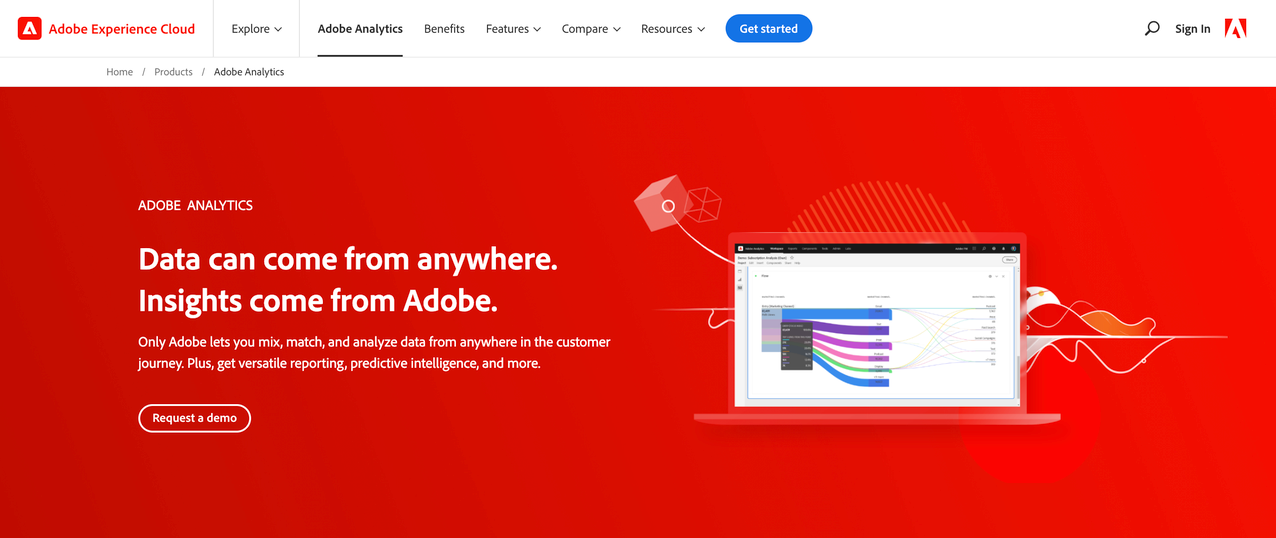
Source: Adobe Analytics
What it is: Adobe Analytics provides a set of tools that lets you collect, measure, and explore data you can use to predict traffic and gain insights. It has an interactive analytics workspace that helps you easily drag and drop data tables, visualizations, and components to create custom analytics dashboards.
Adobe Analytics offers an advanced report pattern that enables you to build and analyze your user journey. The real-time segmentation feature uses a machine learning model to predict customer behavior and reduce churn risk. It also has a flow analysis chart that helps you understand how your customers navigate each page of your site.
How it differs from Google Analytics:
- Adobe Analytics uses a single powerful interface, an “ad hoc analysis workspace,” for reporting, visualizing, and analyzing data. In contrast, Google Analytics uses multiple reporting interfaces—a custom GA interface, Google Data Studio, and Analysis Hub interface (accessible to GA360 users).
- Adobe Analytics workspace has a drag-and-drop option that makes it easy to build and share reports. Although this functionality has improved in Google Analytics 4, it still requires a connection with Google Data Studio to build sophisticated custom reports.
- Adobe Analytics offers multi-channel data collection that gives you the ability to capture data from different sources like web, mobile devices, email, and client server-side applications. In contrast, Google Analytics does not have multi-channel data collection. You can also use RudderStack’s Adobe Analytics integration to send event data from all your websites and mobile apps to Adobe analytics plus all the rest of the tools in your stack.
2. Mixpanel
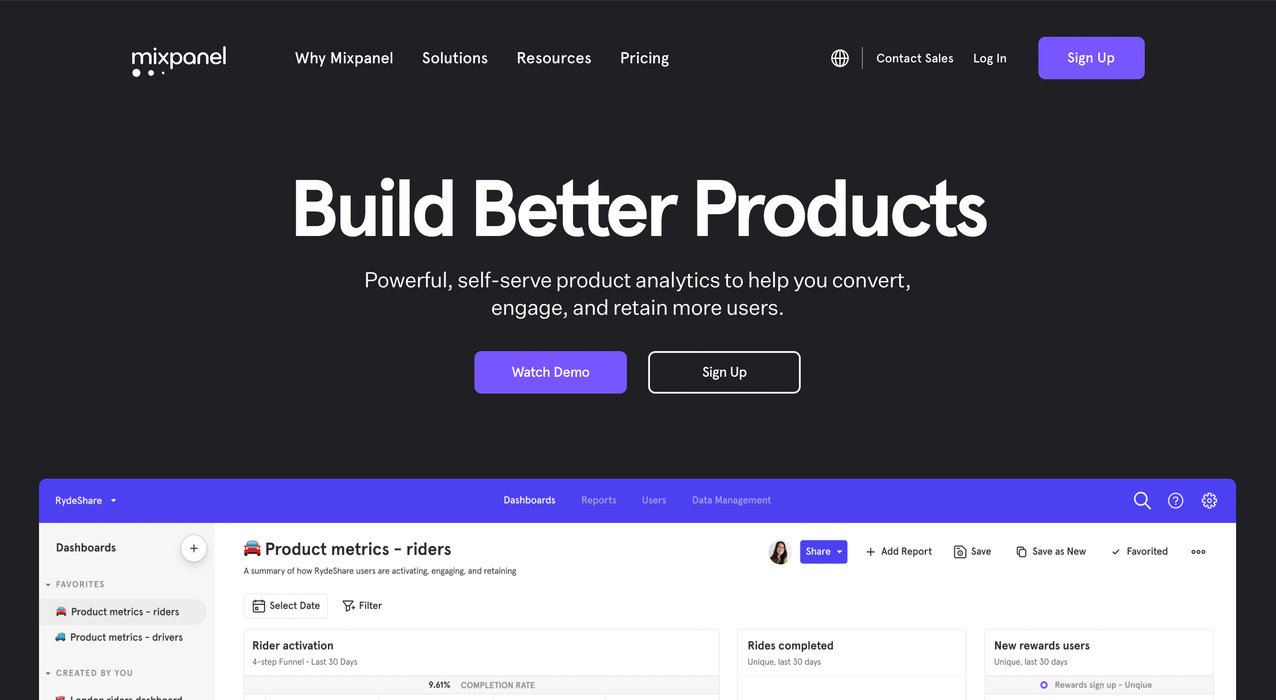
Source: Mixpanel
What it is: Mixpanel is an analytics tool that lets businesses dive deep into user behavior on the website and mobile applications. Mixpanel lets you group your users based on actions they carried or did not carry out on your website and compare trends easily.
With its retention report feature, you can see what group of website users stick around and what keeps them interested. Its dashboards and alerts can be customized in real-time for your team, and you can be notified when metrics change. Mixpanel offers more than 50 integrations, including Content Management Systems (CMS), messaging and marketing automation platforms, databases, customer support systems, etc.
How it differs from Google Analytics:
- Mixpanel empowers you with a flexible data model layer that allows you to transform your data into “Excel-like commands.” In contrast, Google Analytics has a strictly defined data model, which is limiting.
- Mixpanel offers unique real-time reporting of user data. In Google Analytics real-time analytics reporting is limited.
- With Mixpanel, you can easily build custom dashboards (in few minutes) and set alerts for when metrics change. In contrast, Google Analytics’ custom dashboards are rather complex and limiting.
RudderStack’s Mixpanel integration makes it easy for you to send data from every website and app to Mixpanel and every other tool in your stack.
3. Looker
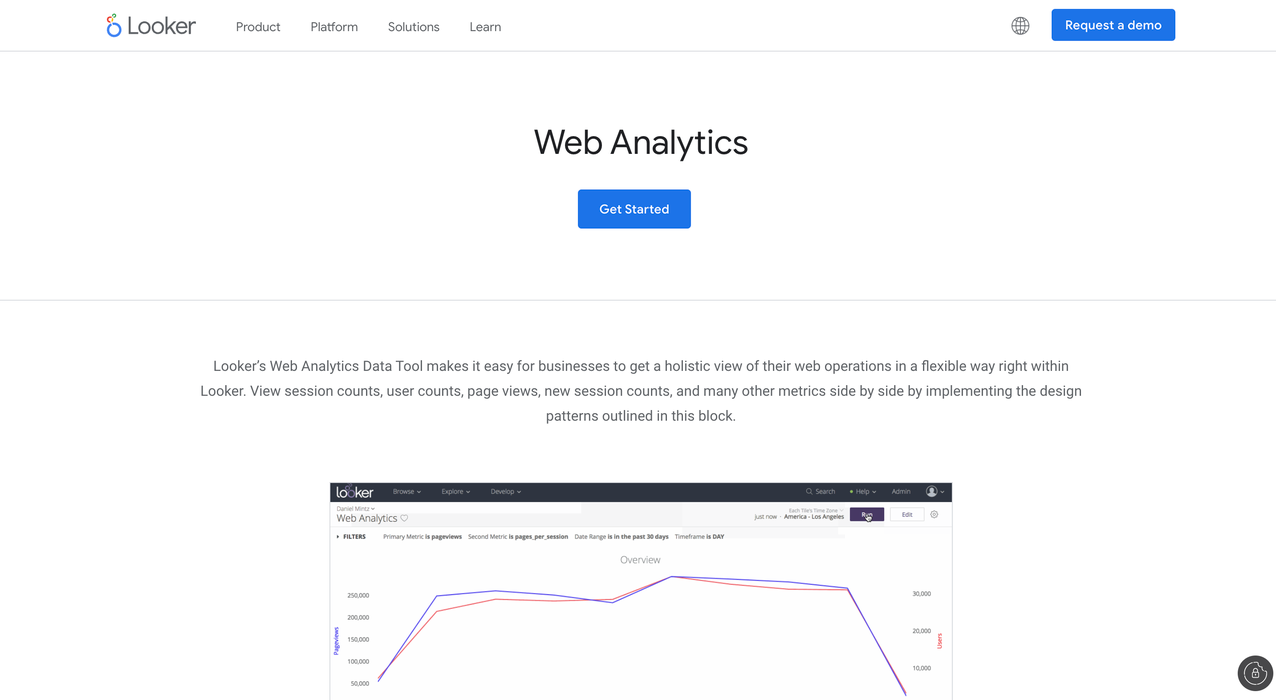
Source: Looker
Looker is a business intelligence and big data analytics platform that provides solutions for exploring, analyzing, and visualizing data in real-time. Looker’s web analytics tool empowers you to create interactions and dynamic dashboards (multiple users can work at the same time). It gives you a 360-degree view of what your customers are doing (for example, unique visitors, session counts, engagements per session).
The dashboard has a number of filters that enable you to slice and dice your web data and get deep, valuable business insights (for example, a property filter for different properties in your website). It also provides on-premise and cloud-hosted options.
How it differs from Google Analytics:
- Looker’s web analytics tool has an easy-to-use UI and dashboard that is understandable by anyone on your team compared to Google Analytics’ complex UI and dashboard.
- Looker’s robust Business Intelligence capabilities go well beyond web analytics, allowing you to custom build reports with any data from your data warehouse.
You can use RudderStack’s warehouse destinations to easily send website and app data to your data warehouse for web analytics and complex Business Intelligence in Looker.
Best Google Analytics alternatives: Open-Source
While enterprise tools are nice to have, these open-source Google Analytics alternatives give you control, flexibility, access to the codebase, and come with friendlier pricing options.
4. PostHog
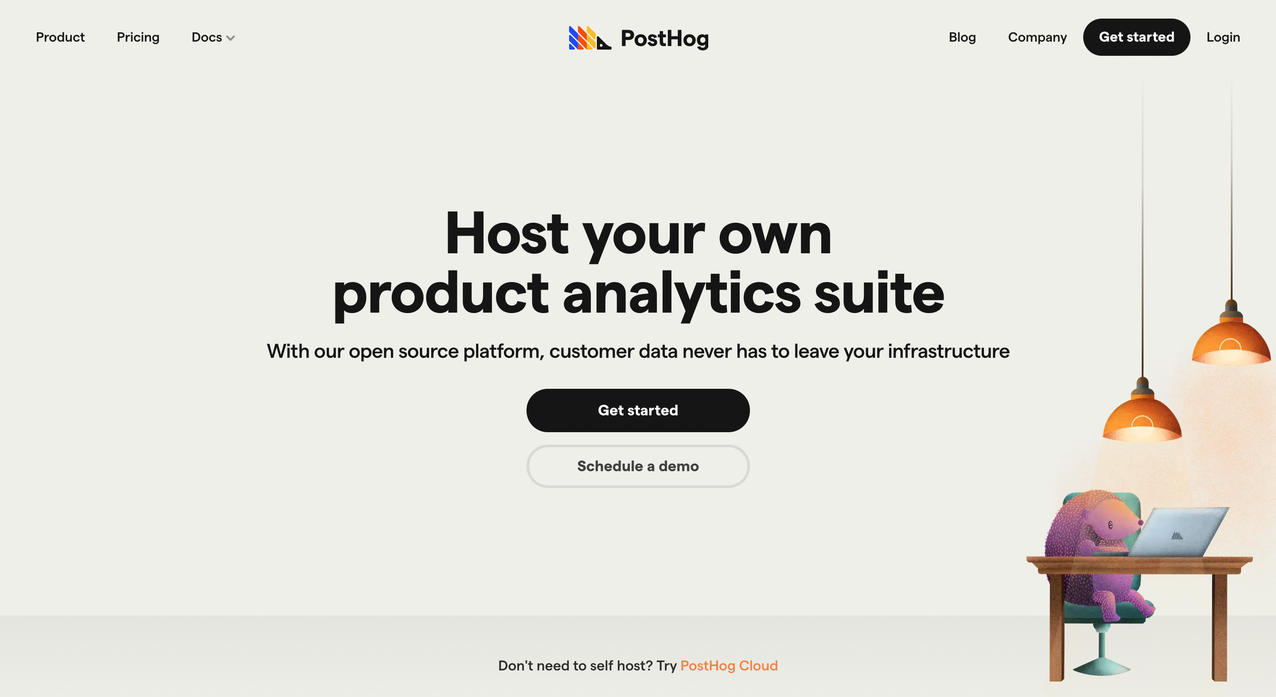
Source: PostHog
What it is: PostHog is an open-source product analytics platform that works directly with your data warehouse and event pipeline to keep you in control of your customer data. It allows you to automatically track different events like clicks, page views, forms, and taps. With PostHog, you can create flexible dashboards to display your product performance metrics like purchases, sign-ups, and conversions. PostHog is excellent if you want to host yourself, with the option to move to the cloud, private cloud deployment, or even keep the data in your infrastructure.
How it differs from Google Analytics:
- PostHog has two unique in-built features that Google Analytics doesn’t have: feature flags and session recordings. Feature flags enable you to deploy and roll out new features to your users. Session recordings enable you to record how your users navigate through your website and allow playback of the individual sessions.
- PostHog has an interactive UI for visualizing your product and web traffic across different user paths, while in Google Analytics, the process is rather complicated and not insightful.
“PostHog is a product analytics platform, rather than just a website analytics platform. Google Analytics is often used by marketing teams to track things like page views, but PostHog can track a much wider range of events and offers specialized tools to help Product and Engineering teams understand why things happen in their product.” — Joe Martin, Head of Product Marketing at PostHog
Check out RudderStack’s PostHog integration to easily send data from every website and app to PostHog and every other tool in your stack.
5. Metabase
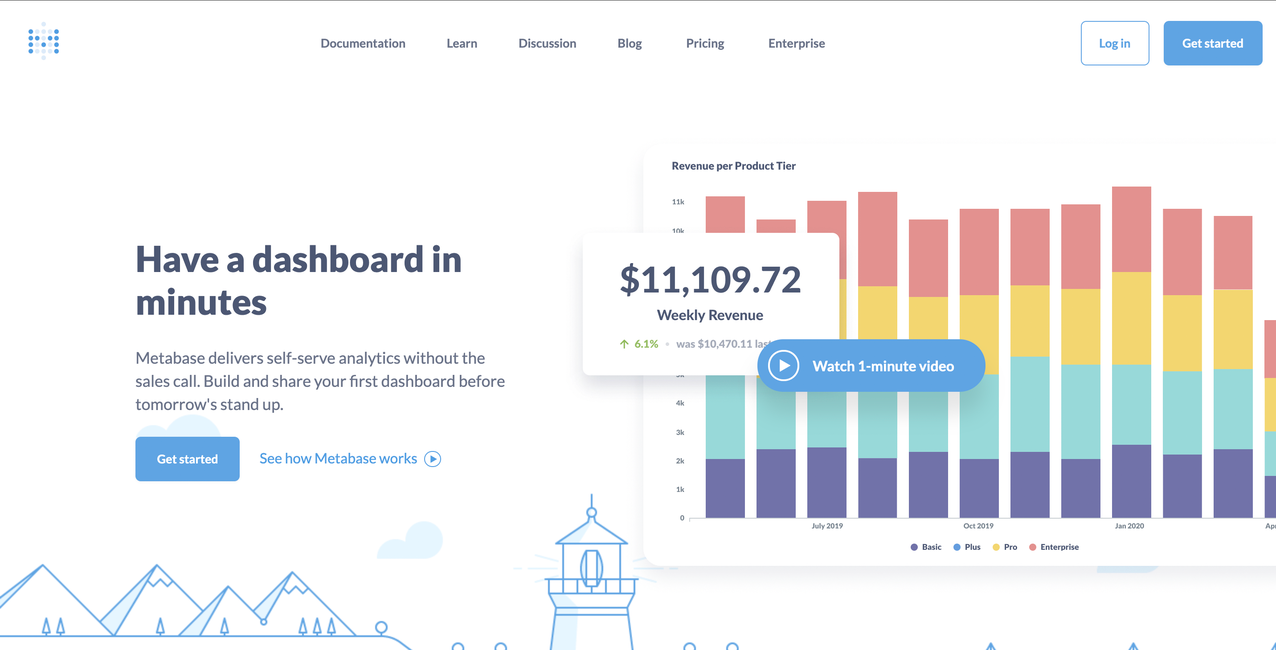
Source: Metabase
What it is: Metabase is an open-source business intelligence and analytics tool that connects your database and provides an easy way for everyone (SQL expert or not) to get answers and learn from the data. It has an interactive dashboard that you can share and automatically create reports. Metabase is not just open-source but also offers cloud and enterprise hosting options.
How it differs from Google Analytics:
- Although Metabase does not completely replace Google Analytics, it enables you to conduct an in-depth analysis of your data.
You can also integrate Google Analytics by adding a database connection and get answers and insights on your data.
Open-source web analytics alternatives
The above tools are specifically for product analytics, but if you are looking out for open-source web analytics alternatives, you can check out the following tools:
6. Plausible
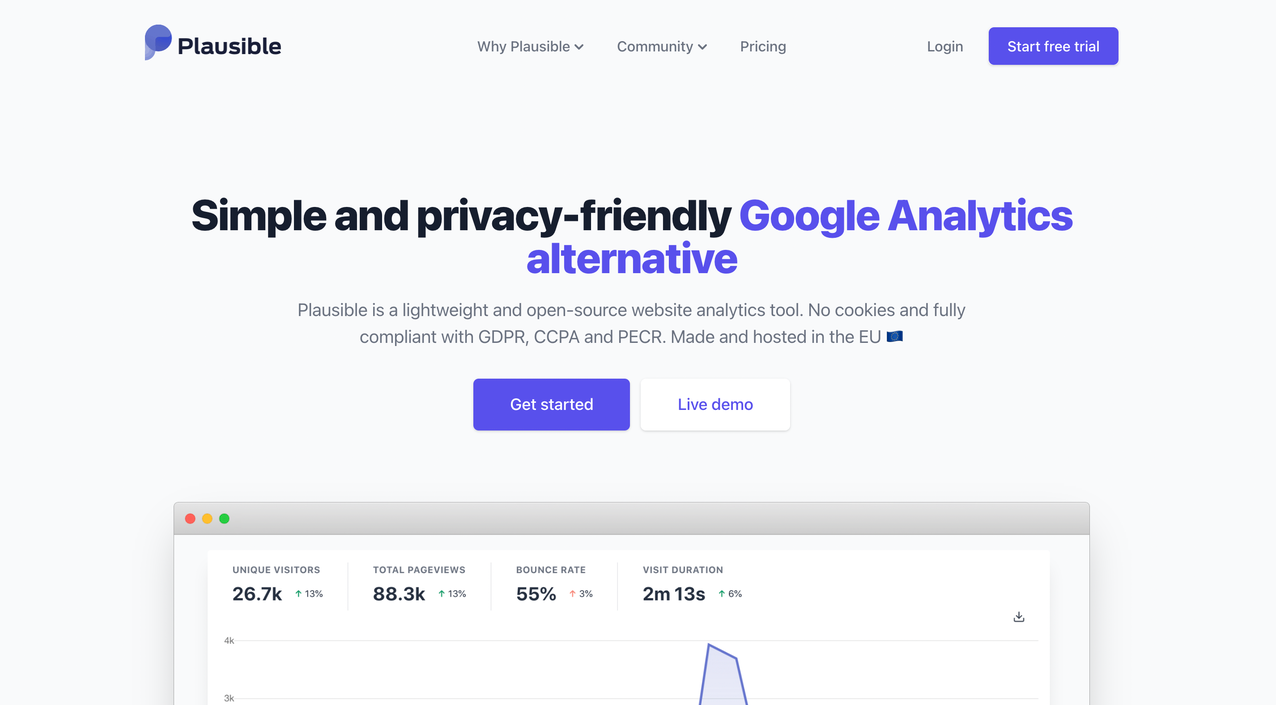
Source: Plausible
What it is: Plausible is an open-source web analytics tool that lets startups, freelancers, and bloggers measure website traffic metrics with an easy-to-use dashboard. This tool uses a single page to present detailed website statistics according to user engagement on your site. The Plausible script is less than 1kb, so you don’t have to worry about it slowing down your site.
With Plausible, your site visitors’ personal data privacy is guaranteed, it does not track users with unique identifiers or require cookies to store data. Plausible uses a public roadmap for feature suggestions and an active community you can engage in.
How it differs from Google Analytics:
- Plausible is a simple analytics tool and requires no training for your team, while Google Analytics is complex and confusing to use.
- Plausible Analytics script is lightweight (it does not affect site speed), while Google Analytics is heavyweight and can slow down your site.
- Plausible Analytics is compliant with GDPR and cookie laws, thereby respecting your site visitors’ privacy. On the contrary, Google Analytics forces you to send out cookies and collect site visitors’ data.
- Plausible Analytics is open source, which means the codebase is publicly available on GitHub, whereas Google Analytics is closed source.
- Plausible offers 100% ownership of your data and self-hosting services, while Google Analytics compromises your data.
7. Matomo
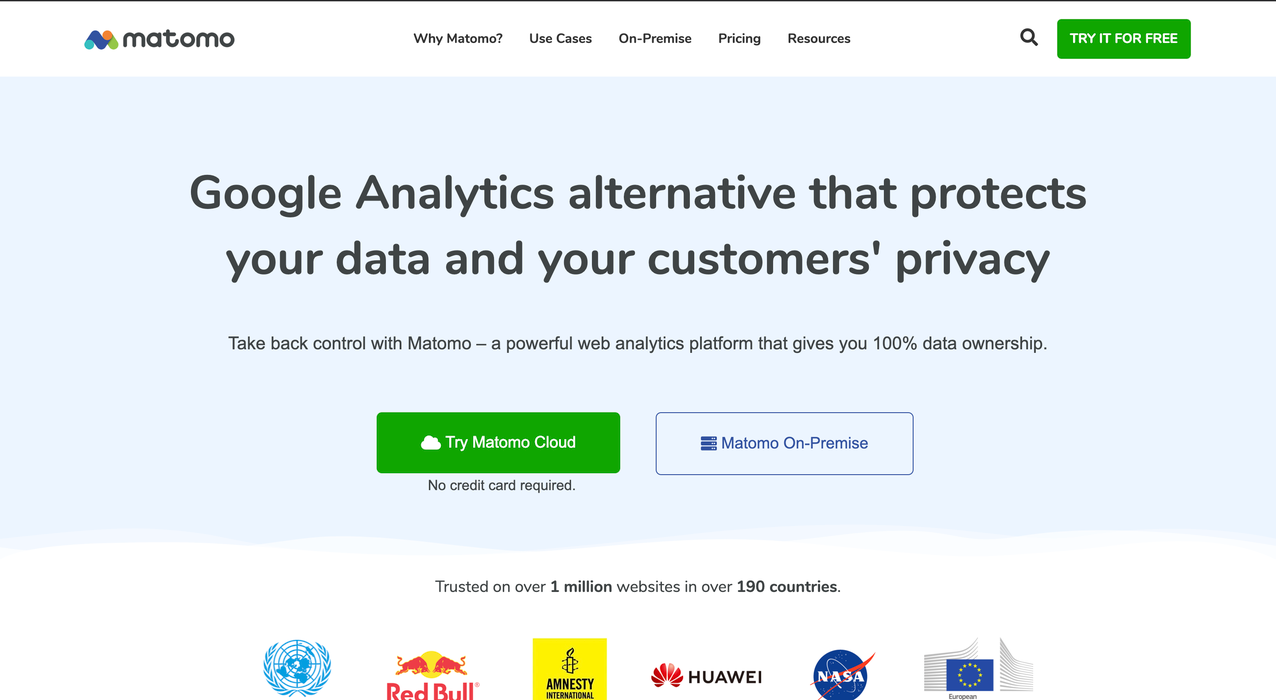
Source: Matomo
What it is: Matomo describes itself as a “powerful web analytics platform” that keeps you in control of your website data. Matomo secures data from your internal websites and intranet applications.
This tool also doesn’t limit data when it comes to tracked websites, reports, segments, goals, page views, number of users, etc. It has easy integration with over 100+ technologies.
How it differs from Google Analytics:
- Matomo makes use of your data for reporting and gives 100% accurate reports, while Google Analytics performs data sampling, which gives inaccurate assumptions over time.
- Matomo is compliant with GDPR, CCPA, and cookie laws, thereby respecting your site visitors’ privacy. On the contrary, Google Analytics forces you to send out cookies and collect site visitors’ data.
- Matomo offers self-hosting, giving you flexibility and control of your data, while Google Analytics is remote-hosted.
- Matomo permits integration with Google Search Console, Bing search console, and Yahoo search console, while Google Analytics limits integrations to just Google Search Console.
Use RudderStack’s Matomo integration to easily send data from your website to Matomo and every other tool in your stack.
8. Open Web Analytics
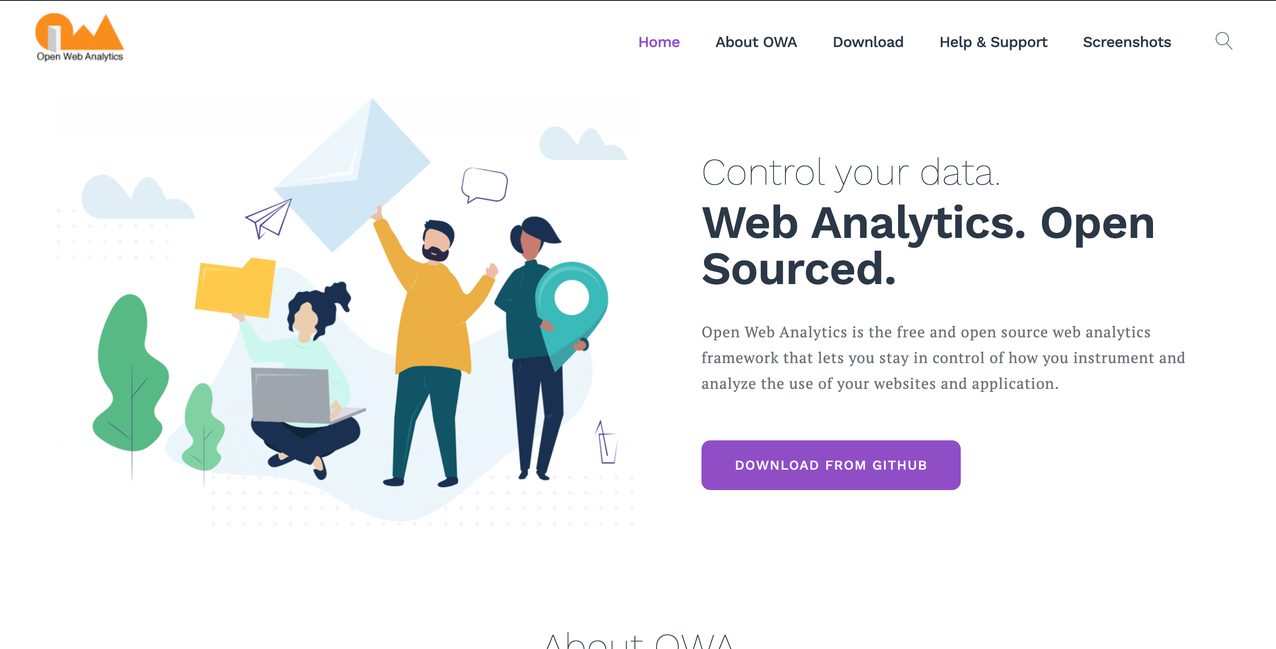
Source: Open Web Analytics
What it is: Open Web Analytics is an open-source web analytics platform that lets you analyze and track your site and app visitors. It offers flexibility to monitor your analytics with a simple and easy-to-use dashboard.
Open Web Analytics allows you to define and track unlimited site actions and interactions. There is a heatmap feature to show you where site visitors click on your website. Open Web Analytics performs custom segments via a data access API and integrates with CRMs like WordPress and MediaWiki.
How it differs from Google Analytics:
- Open Web Analytics uses a built-in heatmap tool to spot where users click and monitor mouse movements. While in Google Analytics, you have to install the Page Analytics extension to access heatmaps.
- Open Web Analytics offers unlimited tracking of multiple websites, while Google Analytics is limited to 50 profiles per account.
- Open Web Analytics has built-in CMS integrations. In contrast, Google Analytics only allows integrations through third-party plugins.
Fuel analytics with unified data collection from a customer data platform
Every analytics tool has a unique set of features and functionalities. In this article we focused on the web and product analytics tools teams use to drive website and app optimizations that enhance the customer experience. Because different teams have different preferences and requirements, it’s not uncommon for a company to leverage multiple analytics solutions, and analytics tools are only a small piece of the puzzle. The initial stack at most companies also includes a CRM tool and a Marketing Automation tool. From there things get increasingly complex, and each new tool requires its own integration. This results in integration maintenance challenges, reduced website and app performance, and data inconsistency across tools in the stack.
You can avoid these problems by unifying data collection with a customer data platform like RudderStack. With RudderStack Event Stream, you instrument your websites and applications once to capture event data in a consistent format and automatically distribute it to every tool in your stack. With a unified data layer you’ll:
- Improve website and app performance
- Eliminate integration maintenance
- Create data consistency at the source
Learn how to build a unified data layer
Our guide to The Starter Stack will help you implement a unified data layer to fuel your analytics and every other tool in your stack.

ABOUT THE AUTHOR
Eric Dodds
Head of Product Marketing at RudderStack
Recent Posts

Subscribe
We'll send you updates from the blog and monthly release notes.

Get started today
Start building smarter customer data pipelines today with RudderStack. Our solutions engineering team is here to help.
This site uses cookies to improve your experience. If you want to learn more about cookies and why we use them, visit our cookie policy. We’ll assume you’re ok with this, but you can opt-out if you wish Cookie Settings.





